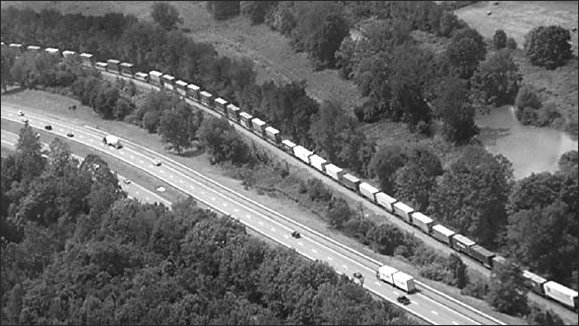
Richard L. Beadles, founder of the Virginia Rail Policy Institute, is dissatisfied with the structure of the U.S. railroad industry. While the rail freight industry has done a good job of moving large volumes of freight long distances, he says, it has yielded the short-haul business to trucks, abandoned thousands of miles of track, and built a system that is to some degree incompatible with passenger rail.
Beadles would like to see more cargo traffic shifting from trucks to rail, thus taking thousands of tractor-trailers off congested highways and reducing energy consumption. And he would like to see more inter-city passenger rail service. The solution, he suggests, is to get government more involved at the federal and state level.
“If rail is going to play a larger role in U.S. transportation, only the public sector can make it happen,” he writes in the May 2017 edition of the Virginia News Letter. “The history of great public-works projects, including the interstate highway system, argues in a most compelling way for a strong public role in rail infrastructure and service planning, augmented with commensurate public funding.”
Beadles calls for setting up a statewide Rail Development Authority. If airports, ports, toll roads, bridges and tunnels all have authorities, he says, publicly sponsored inter-city railroad projects should have one, too. “In the long run, a rail authority will be required for the very same reasons that the highly successful Virginia Port Authority was created year ago. The sooner it is created, the better for the public.”
Setting up a rail authority is not an inherently unreasonable idea, although there could be turf issues with the Virginia Department of Rail and Public Transit, the state agency that currently handles inter-city rail matters. Transferring DRPT’s inter-city rail functions and revenue sources to a quasi-independent authority would avoid bureaucratic redundancy. But it’s not clear from Beadles’ account what an authority could accomplish that DRPT does not.
A more interesting philosophical issue is where the money would come from to fund an expanded role for rail. Beadles makes essentially the same argument that backers of mass transit do — that roads and highways are subsidized, so why shouldn’t rail and transit be, too? Writes Beadles:
Virginia appears at first glance to have a public-policy commitment to raise the necessary revenues from users of highways via fuel taxes, supplemented by other fees and charges. In 1986, a landmark transportation funding package brought the “half-cent for transportation” supplement to the state sales taxes. With the effect of inflation over two decades, the “half-cent” has become a major component of highway funding revenue. Thus even a senior citizen in a retirement community, without an automobile, is now paying into the state transportation revenue pot. And now, with the 2007 General Assembly “solution” to future transportation requirements, part of the funding package includes General Fund money.
Beadles is absolutely right about this. Virginia has abandoned the pretense that roads and highways should be self-funding through a gasoline tax and other auto-related taxes. Not only is asphalt-based transportation subsidized in innumerable ways, freight trucking is subsidized by other drivers; tractor-trailers do not pay taxes sufficient to cover the cost of the wear and tear they inflict upon highways. Thus, they enjoy a doubly unfair advantage over rail.
Of course, passenger rail and mass transit are subsidized, too. Virginia budgeted $52 million for inter-city rail in fiscal 2016. So the debate becomes one of arguing that inter-city rail deserves even bigger subsidies because its goals are so worthy. The trouble with such a debate is that there is no practical way to determine what level of support is economically appropriate.
When it comes to paying for roads, bridges and highways, one could devise a Vehicle Miles Driven tax to generate revenues sufficient to maintain the road network. The tax would be adjusted up and down as needed to cover fluctuating maintenance costs. New construction could be paid for through tolls, proffers, impact fees and Community Development Authority bonds. Virginia could construct a pay-as-you-go financing system for roads if the political will existed.
No one has proposed even a theoretical model of how inter-city rail, outside the densely populated Northeastern Corridor and a few connecting lines, could be fiscally self-supporting. At the very least, Beadles needs to demonstrate a positive net social benefit for public rail investments. He comes close with one example — a $40 million contract with Norfolk Southern — but never completes the logic loop.
In 2007 DRPT provided the funds to upgrade Norfolk Southern’s rail line between Manassas and Front Royal with the goal of shifting freight traffic from Interstate 81 to Norfolk’s Southern’s rail network. Under the contract, the rail company is required to divert 76,000 trucks per year above current levels by 2023. That sounds like a lot of trucks. But the reduction averages 208 trucks per day, slightly less than 9 per hour. How much do nine trucks per hour create in congestion costs, and how much economic value (less drivers’ time lost to congestion) would be saved by getting them off the road? Alternatively, one might ask what other improvements the state could make with $40 million, and what public benefits would be attained. Was the Norfolk Southern subsidy a good public investment or not? We don’t know — not with the information that Beadles provides.
Investing more public money in rail might make economic sense. But I want to see a stronger case for it. An even better idea would be to let roads and rail, trucks and railroads, compete on a level playing field by making all transportation modes operate on a pay-as-you-go basis. I have more faith in truckers and railroaders than politicians to make decisions that make economic sense.


